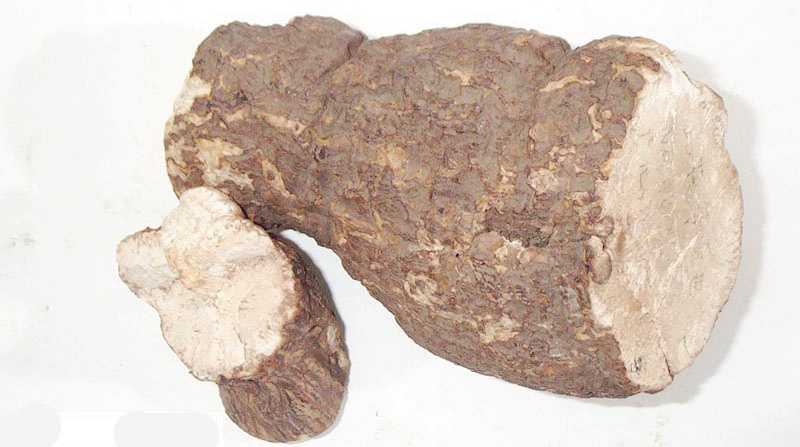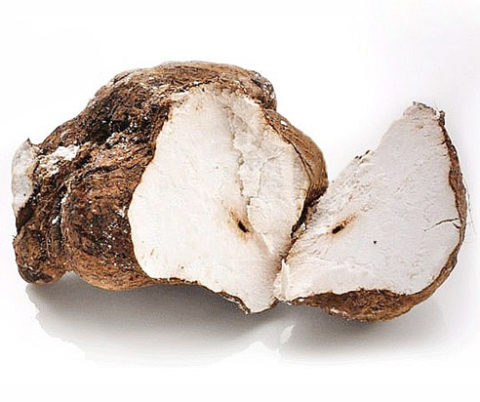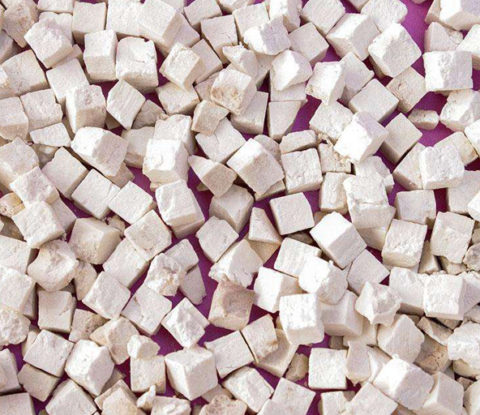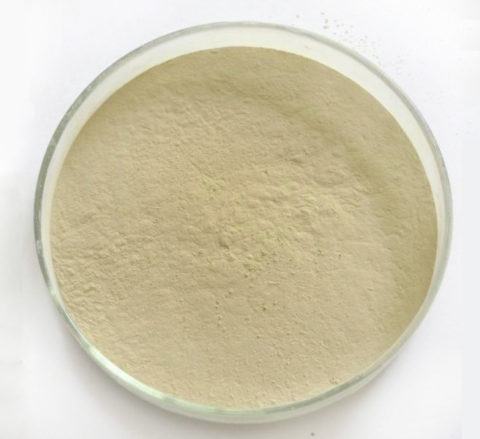
Poria Cocos Extract Powder Polysaccharides 10%, 20%, 30%,50% UV, 10:1, 20:1TLC
Poria cocos is used in traditional Chinese medicine for edema, urinary incontinence, phlegm and fluid dizziness, spleen deficiency, food deficiency, loose stools, diarrhea, restlessness, palpitations, and insomnia.
Poria Cocos Extract Powder Polysaccharides 10%, 20%, 30%,50% UV, 10:1, 20:1TLC
【Latin name】: Poria cocos (Schw.) Wolf
【Other names】: Poria , fu-ling (Mandarin/Chinese), tuckahoe , Indian bread , hoelen (Japanese)
【Part of used】: fruitbody and mycelium
【Active ingredients】: Polysaccharides (including β-glycosidic)
【Specification】: Polysaccharides 10%, 20%, 30%,50% UV, 10:1, 20:1TLC
【Appearance】: brown fine powder( mycelium) or offwhite fine powder( fruitbody)
【Odor】: characteristic
【Particle size】: 100% pass 80 mesh

Poris Cocos Extract Powder Production Flowchart
Poris mushroom raw materials – natural air drying–Coarse powder(40 mesh) -Low temperature water extraction – 1st Reflux Extraction(10 times water,2 Hrs) – 2nd Reflux Extraction8 times water,1.5 Hrs) – 3rd Reflux Extraction(6 times water,1 Hrs) – Extraction Solution-combine&Filtrate-Concentrate-Extractum-spray drying – screening – packaging – detection of physical and chemical indicators – warehousing
Specification of Poris Cocos Extract Powder
| Item | Standard | Test method |
| Appearance | Brownish Yellow fine powder | Visual & Organoleptic |
| Specification | Polysaccharides 30% | UV |
| Particle size | 80 mesh | Pass 80 mesh size screen |
| Ash | <13% | 2g/525℃/3hrs |
| Moisture | <7% | 5g/100℃/2.5hrs |
| Heavy metals | As <1.0ppm Pb<2.0PPM Hg<0.2ppm Cd<1.0ppm | Atomic Absorption |
| Microbiological Control | Total Plate Count<10,000cfu/g, Yeast & Mold<100cfu/g, E.Coli<10cfu/g. |
AOAC |
| Packing | 1kg/bag, 5kg/bag, or 25kg/fiber drum (D* H, 40*50cm),
It can also be packaged according to the requirements of customers, and all the packaging materials meet the standards of Chinese Pharmacopoeia 2010. |
|
General Introduction
Poria, a saprophytic fungus that grows on pine tree roots, has a large potato-shaped formation known as a sclerotium that can be as large as 30 cm long and 1 kg in mass. The texture is soft and elastic, and the flavor is sweet and bland. The fungus is harvested and then dried in the shade. Different parts of fu-ling are used in Chinese medicine including the bark (fu-ling-pi), outermost reddish layer (chih-fu-ling), middle white layer (bai-fu-ling), and the core (fu-shen). P. cocos synonyms include Sclerotium cocos , Wolfiporia extensa , Wolfiporia cocos , Daedalea extensa , Macrohyporia extensa , Macrohyporia cocos , and Pachyma cocos.
Poria has been used in Chinese and Japanese medicine for “draining dampness,” and to treat insomnia, balance electrolytes, and invigorate the spleen. Poria has been known as “the medicine of immortality” and is widely used in Asia, with approximately 10% of medicinal preparations in the 2000 Pharmacopoeia of the People’s Republic of China containing fu-ling.Owing to its wide range of medical uses and neutral nature, it is honored as dampness-eliminating panacea and one out of Eight Treasures. As a result, this herb is commonly used in not only many clinical formulas but also the production of numerous Chinese patent medicines. What’s more, thanks to its amazing health benefits, it was once used to make a variety of delicacies and snacks for the enjoyment of all members of the royal family.
Chemical Components
Poria contains 2 main chemical groups, polysaccharides and triterpenes. Several reports have identified lanostane triterpene derivatives, polyporenic acid C, pachymaic acid, pachymic acid, tumulosic acid, a carboxylic acid, and dehydropachymic acid. Several monosaccharides, including the D- forms of glucose, xylose, mannose, galactose, fucose, and rhamnose, have been identified. The glucan pachyman has specifically been evaluated. Naming contradictions for the various monosaccharides exist in the literature. Poria also contains amino acids, enzymes, steroids and choline, as well as histidine and potassium salts.
Indications of Poria Cocos in TCM
1). Edema and dysuria
It can induce diuresis and drain dampness to eliminate the pathogens, and invigorate spleen to reinforce healthy. Its property is mild, tonic but not stagnant, and diuretic without consumption. It is an essential herb for inducing diuresis and alleviating edema. For various edema no mater cold, heat, deficiency or excess types, it is usually combined with Zhu Ling to mutually promote the effect of inducing diuresis and draining dampness. And the combination with other herbs depends on differentiation. For edema and dysuria due to water-damp retention, it is usually combined with Zhu Ling, Ze Xie, Bai Zhu, Gui Zhi such as in Wu Ling San from Shang Han Lun. For edema due to spleen and kidney deficiency, it is usually combined with yang-warming and diuresis-inducing herbs. For instance, it is combined with Fu Zi and Sheng Jiang in Zhen Wu Tang from Shang Han Lun. For the water-heat accumulation syndrome, edema due to yin deficiency and dysuria, it is combined with yin-tonifying and diuresis-inducing herbs. For instance, it is combined with Zhu Ling, E Jiao and Ze Xie in Zhu Ling Tang from Shang Han Lun. For edema due to spleen deficiency, it is usually combined with qi-tonifying and spleen-invigorating and diuresis-inducing herbs such as Bai Zhu, Huang Qi to mutually reinforce.
2). Spleen deficiency syndrome
This herb is mild to invigorate spleen. For all the syndromes due to spleen deficiency, it is always combined with Ren Shen and Dang Shen as their assistant. For instance, it is combined with Ren Shen, Bai Zhu, and Gan Cao in Si Jun Zi Tang which is the main spleen and stomach-tonifying formula from Tai Ping Hui Min He Ji Ju Fang. Spleen controls body fluid circulation. The dysfunction of spleen can lead to water-damp retention easily. It is good at inducing diuresis and tonifying spleen, so it is usually combined with qi-tonifying and spleen-invigorating herbs and damp-drying and diarrhea-checking d-rugs. For instance, it is combined with Ren Shen, Bai Zhu, and Yi Yi Ren in Shen Ling Bai Zhu San from Tai Ping Hui MIn He Ji Ju Fang, and indicated for indigestion, borborygmus and diarrhea due to spleen deficiency with damp harassment.
3). Palpitation and insomnia
It has the action of inducing tranquilization and is indicated for palpitation and insomnia caused by different causes. For palpitation, insomnia, and amnesia due to qi and blood deficiency or spleen-heart deficiency, it is usually combined with qi-tonifying, blood-nourishing herbs and tranquilizers. For instance, it is combined with Huang Qi, Dang Gui, and Yuan Zhi in Gui Pi Fang from Ji Sheng Fang. For restlessness and fear due to heart-qi deficiency, it is usually combined with heart-qi-tonifying herbs and settling tranquilizers. For instance it is combined with Ren Shen, Yuan Zhi, and Long Chi in An Shen Ding Zhi Wan from Yi Xue Xin Wu.
4). Phlegm-fluid retention
It can invigorate spleen, drain and excrete water-damp to prevent the retention of damp and production of phlegm. And it can also calm heart and induce tranquilization. So it is suitable for syndrome of spleen deficiency with fluid-retention or syndrome of attack of heart by retained water manifested as fullness in the chest and hypochondrium, palpitation and dizziness, and cough with shortness of breath. It is usually combined with spleen-invigorating, dampness-drying, heart-yang-warming herbs. For instance it is combined with Gui Zhi, Bai Zhu, and Gan Cao in Ling Gui Zhu Gan Tang from Jin Kui Yao Lue. For vomiting due to fluid retention in stomach, it should be combined with herbs of directing qi downward and arresting vomiting. For instance it is combined with Ban Xia and Sheng Jiang in the Xiao Ban Xia Jia Fu Ling Tang from Jin Kui Yao Lue. Because it is good at invigorating spleen and draining dampness, it is indicated for phlegm-damp syndrome. For instance, it is used in Er Chen Tang from Tai Ping Hui Min He Ji Iu Fang to reinforce the dampness-drying and phlegm-resolving actions of Ban Xia and Chen Pi.
Modern Pharmacological Actions
1. Diuretic effect. Experiments showed that poria mushroom alone had no diuretic effect at all. However, when used in formula of Wu Ling San, it showed significant diuresis in dogs by intravenous injection and healthy people and rabbit by oral decoction. And increased excretion of sodium, potassium, chloride was found in dogs. But it was reported that the main diuretic herbs in this formula are Gui Zhi (Cinnamon Twig), Ze Xie (Water Plantain Root), and Bai Zhu (Atractylodes);
2. Antibacterial effect. Experiment in vitro found no bacteriostatic action. Poria extract by ethanol instead of water can kill leptospira in vitro;
3. Effects on the digestive system. This herb can directly relax the isolated rabbit intestine, prevent pylorus ligation-induced gastric ulcer in rats, and reduce stomach acid;
4. Other effects. It can lower blood sugar. Its tincture and infusion can inhibit the isolated toad heart. Poria cocos extract by ether or ethanol can strengthen cardiac contractility. But it showed no antiemetic effect to digitalis induced vomiting.
Applications
Hoelen (Poria cocos) is a therapeutic mushroom, which is also used as a daily food in many parts of the world. Known to be a rich natural source of mineral potassium, hoelen also possesses effectual anti-bacterial and diuretic attributes. In Traditional Chinese Medicine (TCM) as well as Native American medicine, this herb is widely used to heal kidney problems. In addition, in traditional Chinese medicine, this mushroom has also been used to bring down high blood sugar level and also to regulate the secretion of stomach acids. In China, this herb has been traditionally used to prepare tonic soup for aged people and those enduring debility. Children also benefit from hoelen (Poria cocos), as it provides them with growth as well as sustenance. According to Traditional Chinese Medicine (TCM), this herb is believed to provide comfort to the heart, reinforce essential energy as well as alleviate disturbance. Like in the case of other mushrooms, Poria cocos can also be digested as well as taken up by the body very easily and this is one reason why this herb is held in high esteem.
The herb Poria cocos possesses several polysaccharides and currently scientists are studying their effective use as a medication. Poriatin and beta-pachyman are among the several polysaccharides contained by this mushroom. In effect, it has been found that poriatin is effective in augmenting the anti-cance-r actions in a number of chemotherapeutic agents. On the other hand, beta-pachyman has also exhibited anti-tumo-r activities and, at the same time, it possesses the aptitude to adjust the immune system. Like people use reishi mushrooms, long back, women belonging to the Imperial court in China used hoelen as a skin treatment agent to nourish, moisturize, and put off pimples as well as to support glowing and youthful skin.
It has also been found that hoelen possesses anti-inflammatory actions when taken orally as well as when it is applied externally. Of late, two patents have received approvals for using Poria cocos as ingredient in creams meant for treatment of skin disorders. While one patent has been approved for using the herb in creams for treating acne and oily skin, the other is meant for healing damaged skin.
Poria cocos or hoelen is basically a mushroom that can function both as an acid or a base and has the aptitude to normalize both high and low sodium and potassium levels in the body and help maintain a normal balance of both these substances. In traditional Chinese medicine Poria cocos is known as Fu Ling and is used to eliminate the dampness of the spleen. In effect, when an individual has too much mugginess as well as deficit of spleen, it is evident as the person develops symptoms, such as diarrhea, poor desire for food and lethargy. In addition, in traditional Chinese medicine Poria cocos is also given to patients enduring restiveness, sleep disorder, insomnia or sleeplessness, exhaustion, tension and nervous anxiety. Even in herbal medication, this herb is prescribed to treat exhaustion, tension, nervousness, sleep disorder, insomnia and lassitude.
Poria cocos or hoelen is now regarded as the latest variety of nourishing health food that helps to regulate the immune system. This herb has the potential not only to reinforce the physiological activities of an individual, but also to help them keep away from diseases. In addition, hoelen has the aptitude to support the functional recuperation of the immune system in humans. Moreover, Poria cocos has the aptitude to encourage or promote the stimulation of the interferon (an assortment of proteins) as well as leukocytic opsonin. The herb also has oblique anti-neoplastic as well as antiviral actions and diminishes the side effects caused by chemotherapy and radiation. Among other things, hoelen is also effective in protecting the liver, promoting long life, soothing the nervous system, reducing the CPT enzyme, supporting the stomach and, at the same time, enhancing one’s looks or appearance.
Proven Poria Fungus Related Chinese Herbal Formulas
Tradition Chinese medicine (TCM) believes that this herb is sweet and tasteless in flavor and neutral in properties. It covers meridians of heart, lung, spleen, and kidney. Its key functions are percolating dampness and disinhibiting water, strengthening the spleen and stomach, and tranquilizing heart and soothe the nerves. Vital poria uses and indications include difficult urination, edema-induced swelling, choking cough caused by phlegm and retained fluid, vomiting, reduced appetite due to spleen deficiency, diarrhea, palpitations, anxiety, insomnia, forgetfulness, and nocturnal emission, gonorrhea, and so on. Recommended dosage is from 10 to 15 grams in decoction.
Gui Zhi Fu Ling Wan (Cinnamon and Poria Pills)
This formula comes from Jin Gui Yao Lue (Essential Prescriptions of the Golden Coffer). It is basically formulated for women’s abdominal masses, blood stasis-induced amenorrhea, menstrual pain, postpartum lochia, and more. Other herbal ingredients are Cinnamon Twig, Mu Dan Pi (Tree Peony Root Cortex), Chi Shao (Red Peony Root), and Tao Ren (Peach Seed).
Zhu Ling San
Zhu Ling San comes from Shang Han Lun (On Cold Damage). It is mainly designed for the binding of water and heat and edema caused by inhibited urination. Other three herbs are Hua Shi (Talcum Powder), E Jiao (Donkey-Hide Glue), and Water Plantain Root.
Ling Gui Zhu Gan Tang
Ling Gui Zhu Gan Tang is from Essential Prescriptions of the Golden Coffer. It is exclusively for dizziness and palpitations due to phlegm and retained fluid. Other three herbs are Cinnamon Twig, Bai Zhu (White Atractylodes), and Gan Cao (Licorice Root).
Si Jun Zi Tang
Si Jun Zi Tang is from Tai Ping Hui Min He Ji Ju Fang (Formulas of the Peaceful Benevolent Dispensary). It is primarily used for deficiency of spleen and stomach, malaise and fatigue, and reduced appetite and loose stool. Other three herbs are Ren Shen (Ginseng Root), White Atractylodes Rhizome, and Licorice Root.
Gui Pi Tang
Gui Pi Tang is from Ji sheng fang (Formulas to Aid the Living). This prescription is mainly used for heart-spleen deficiency and deficiency of qi and blood-induced palpitations, insomnia, and forgetfulness. The rest basic herbs are Huang Qi (Astragalus Root), Dang Gui (Dong Quai), and Yuan Zhi (Senega Root).






